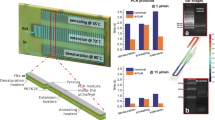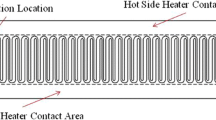Abstract
Two types of micro-PCR (polymerase chain reaction) devices, a continuous-flow and a static-chamber device, with specifications imposed from flexible printed circuit technology, are compared through a computational study. Models for laminar flow, heat transfer in both solid and fluid, mass conservation of species, Joule heating, PCR kinetics, and temperature control feedback are coupled. The comparison is performed under identical conditions: the same material stack, i.e., flexible thin polymeric films with metal layers for integration of microheaters, the same volume of PCR mixture, and the same PCR protocol. Performance is quantified in terms of DNA amplification, energy consumption, and total operating time. The calculations show that the efficiency of DNA amplification is almost the same in both devices. However, contrary to what is generally believed, the static-chamber device fabricated on thin substrates, despite the necessary temperature ramping up within each thermal cycle, requires (2–4 times) lower energy consumption compared to the continuous-flow device. The constant energy losses to the ambient continuously during the operation of the continuous-flow device overcome the energy required for the thermal cycling of the static-chamber device. However, this result is reversed when the substrate thickness increases above 1000 μm. Concerning the speed, the total time required for the static-chamber device is only 1.1–2 times greater than that of the continuous-flow device due to relatively rapid heating and cooling rates for such thin substrates. These advantages for static-chamber micro-PCR devices arise as a result of the small thickness of the substrate where microchannels and microheaters are closely spaced. Both the low energy consumption and the inherent protocol flexibility indicate an attractive potential for static-chamber micro-PCR devices realized on flexible thin substrates with integrated microheaters.










Similar content being viewed by others
References
Ahmad F, Hashsham SA (2012) Miniaturized nucleic acid amplification systems for rapid and point-of-care diagnostics: a review. Anal Chim Acta 733:1–15
Allen J, Kenward M, Dorfman K (2009) Coupled flow and reaction during natural convection PCR. Microfluid Nanofluid 6:121–130
Amasia M, Kang S-W, Banerjee D, Madou M (2013) Experimental validation of numerical study on thermoelectric-based heating in an integrated centrifugal microfluidic platform for polymerase chain reaction amplification. Biomicrofluidics 7:014106
Athavale M, Chen Z, Furmanczyk M, Przekwas A (2001) Coupled multiphysics and chemistry simulations of PCR microreactors with active control. In: Nanotech (ed) Modeling and simulation of microsystems. Nanotech, South Carolina, pp 574–577
Becker H, Hlawatsch N, Klemm R, Moche C, Hansen-Hagge T, Gartner C (2014) Real-time PCR in microfluidic devices. In: SPIE (ed) Microfluidics, BioMEMS, and medical microsystems XII. SPIE, San Francisco, p 89760Z
Brunklaus S et al (2012) Fast nucleic acid amplification for integration in point-of-care applications. Electrophoresis 33:3222–3228
Cao Q, Kim M-C, Klapperich C (2011) Plastic microfluidic chip for continuous-flow polymerase chain reaction: simulations and experiments. Biotechnol J 6:177–184
Chen ZY, Qian SZ, Abrams WR, Malamud D, Bau HH (2004) Thermosiphon-based PCR reactor: experiment and modeling. Anal Chem 76:3707–3715
Chen PC et al (2010) Titer-plate formatted continuous flow thermal reactors: design and performance of a nanoliter reactor. Sens Actuators, B Chem 149:291–300
Chen P-C, Fan W, Hoo T-K, Chan LCZ, Wang Z (2012) Simulation guided-design of a microfluidic thermal reactor for polymerase chain reaction. Chem Eng Res Des 90:591–599
Chou CF et al (2002) A miniaturized cyclic PCR device—modeling and experiments. Microelectron Eng 61–62:921–925
Crews N, Wittwer C, Gale B (2008) Continuous-flow thermal gradient PCR. Biomed Microdevices 10:187–195
Dittmar R, Gill S, Singh H, Darby M (2012) Robust optimization-based multi-loop PID controller tuning: a new tool and its industrial application. Control Eng Prac 20:355–370
Gärtner C, Klemm R, Becker H (2007) Methods and instruments for continuous-flow PCR on a chip. In: SPIE (ed) Microfluidics, BioMEMS, and medical microsystems. SPIE, San Jose, p 646502
Hashimoto M, Chen PC, Mitchell MW, Nikitopoulos DE, Soper SA, Murphy MC (2004) Rapid PCR in a continuous flow device. Lab Chip 4:638–645
Hunicke-Smith SP (1997) PCR and cycle sequencing reactions: a new device and engineering model (Ph.D. Thesis). Stanford University
Ibrahim O, Jones B, Hassab M, Op de Beeck M (2014) Three-dimensional transient thermal analysis for a silicon PCR Microreactor. Numer Heat Tr A—Appl 65:1069–1088
Jeng JC, Tseng WL, Chiu MS (2014) A one-step tuning method for PID controllers with robustness specification using plant step-response data. Chem Eng Res Des 92:545–558
Kang J, Chen C, Smolinski J, Thomas R, Tucker J, Auner G (2006) Simulation and optimization of a flow-through micro PCR chip. In: Nanotech (ed) NSTI Nanotech. Nanotech, Boston, Massachusetts, pp 585–588
Kopp MU, Mello AJd, Manz A (1998) Chemical amplification: continuous-Flow PCR on a chip. Science 280:1046–1048
Krishnan M, Ugaz VM, Burns MA (2002) PCR in a Rayleigh–Bénard convection cell. Science 298:793
Kumar S, Thorsen T, Das SK (2008) Thermal modeling for design optimization of a microfluidic device for continuous flow polymerase chain reaction (PCR). In: ASME (ed) ASME 2008 heat transfer summer conference collocated with the fluids engineering, energy sustainability, and 3rd energy nanotechnology conferences. ASME, Jacksonville. pp 323–330
Li L, Wang C, Song B, Mi L, Hu J (2012) Kinetic parameters estimation in the polymerase chain reaction process using the genetic algorithm. Ind Eng Chem Res 51:13268–13273
Liu J, Enzelberger M, Quake S (2002) A nanoliter rotary device for polymerase chain reaction. Electrophoresis 23:1531–1536
Lok KS, Lee PPF, Kwok YC, Nguyen NT (2012) Nested PCR in magnetically actuated circular closed-loop PCR microchip system. Microchim Acta 177:111–117
Mehra S, Hu W-S (2005) A kinetic model of quantitative real-time polymerase chain reaction. Biotechnol Bioeng 91:848–860
Mohammed A, Adeniyi AA, Hassan AB (2012) Modelling of serpentine continuous flow polymerase chain reaction microfluidics. IJEST 4:1183–1189
Mohr S et al (2007) Numerical and experimental study of a droplet-based PCR chip. Microfluid Nanofluid 3:611–621
Moschou D, Vourdas N, Kokkoris G, Papadakis G, Parthenios J, Chatzandroulis S, Tserepi A (2014) All-plastic, low-power, disposable, continuous-flow PCR chip with integrated microheaters for rapid DNA amplification. Sensor Actuat B—Chem 199:470–478
Niu ZQ, Chen WY, Shao SY, Jia XY, Zhang WP (2006) DNA amplification on a PDMS-glass hybrid microchip. J Micromech Microeng 16:425–433
Obeid PJ, Christopoulos TK (2003) Continuous-flow DNA and RNA amplification chip combined with laser-induced fluorescence detection. Anal Chim Acta 494:1–9
Papadopoulos VE et al (2014) A passive micromixer for enzymatic digestion of DNA. Microelectron Eng 124:42–46
Park DSW et al (2010) Titer plate formatted continuous flow thermal reactors for high throughput applications: fabrication and testing. J Micromech Microeng 20:055003
Perry RH, Green DW, Maloney JO (1999) Perry’s chemical engineer’s handbook on CD-ROM. McGraw-Hill, San Francisco, Washington, New York
Priye A, Hassan YA, Ugaz VM (2013) Microscale chaotic advection enables robust convective DNA replication. Anal Chem 85:10536–10541
Shen K, Chen X, Guo M, Cheng J (2005) A microchip-based PCR device using flexible printed circuit technology. Sensor Actuat B—Chem 105:251–258
Sun Y, Kwok YC, Nguyen NT (2007) A circular ferrofluid driven microchip for rapid polymerase chain reaction. Lab Chip 7:1012–1017
Thomas S, Orozco R, Ameel T (2014) Thermal gradient continuous-flow PCR: a guide to design. Microfluid Nanofluid 17:1039–1051
Wang S, Wang W (2010) Kinetic characteristics of continuous flow polymerase chain reaction chip: a numerical investigation. Sci China Technol Sci 53:1967–1972
Wang W, Li ZX, Luo R, Lu SH, Xu AD, Yang YJ (2005) Droplet-based micro oscillating-flow PCR chip. J Micromech Microeng 15:1369–1377
Wang Y, Pant K, Grover J, Sundaram S (2007) Multi-physics simulational analysis of a novel PCR micro-device. Nanotech 3:456–459
Zhang Y, Ozdemir P (2009) Microfluidic DNA amplification—a review. Anal Chim Acta 638:115–125
Acknowledgments
This work is partly supported by the EU Project (FP7-ICT-2011.3.2) LOVE-FOOD: Love wave fully integrated Lab-on-Chip platform for food pathogen detection (Grant Agreement No: 317742) and the GSRT “SYNERGASIA” Project “Converging Lamb wave sensors with microtechnologies towards an integrated Lab-on-chip for clinical diagnostics-Lambsense.”
Author information
Authors and Affiliations
Corresponding authors
Electronic supplementary material
Below is the link to the electronic supplementary material.
Rights and permissions
About this article
Cite this article
Papadopoulos, V.E., Kokkoris, G., Kefala, I.N. et al. Comparison of continuous-flow and static-chamber μPCR devices through a computational study: the potential of flexible polymeric substrates. Microfluid Nanofluid 19, 867–882 (2015). https://doi.org/10.1007/s10404-015-1613-1
Received:
Accepted:
Published:
Issue Date:
DOI: https://doi.org/10.1007/s10404-015-1613-1




